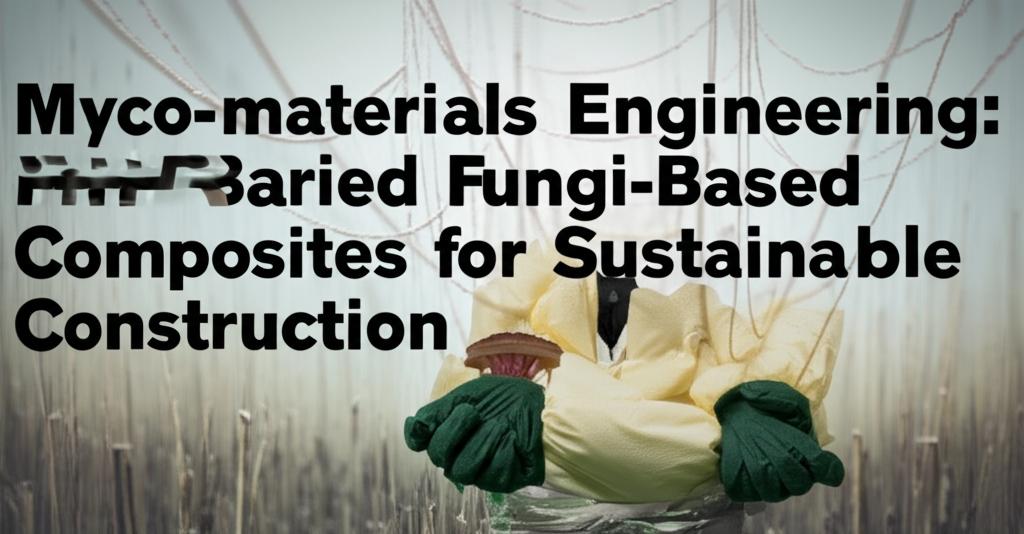Myco-materials, derived from mycelium (the root network of fungi), are rapidly emerging as a revolutionary and sustainable alternative to conventional building materials. These fungi-based composites offer a compelling combination of environmental benefits, unique physical properties, and versatility in construction applications.
Environmental and Economic Advantages: Mycelium-based materials present a significant step towards a circular economy and reduced carbon footprint in the construction industry. They are biodegradable, often carbon-negative (as they can sequester carbon during growth), and can be cultivated on agricultural waste products, thereby turning waste into valuable resources. This process minimizes landfill waste and the pollution associated with traditional material manufacturing. While initial costs might be higher in some cases, their lifecycle costs are competitive, especially when considering energy savings from superior insulation and reduced environmental impact. Production and Properties: The production of myco-materials involves inoculating a substrate of organic waste (like sawdust, agricultural byproducts, or other fibrous materials) with fungal spores. The mycelium then grows, forming a dense network that binds the substrate together. This mixture can be molded into desired shapes and sizes. Once the mycelium has fully colonized the substrate, it is typically dried or heat-treated to stop further growth and ensure durability.Key properties of mycelium composites include:
- Lightweight yet Strong: Mycelium composites can be engineered to be surprisingly strong and durable, sometimes comparable to materials like polystyrene or particleboard, while being significantly lighter.
- Excellent Insulation: They possess natural thermal and acoustic insulation properties, often outperforming traditional insulation materials. This contributes to improved energy efficiency in buildings.
- Fire Resistance: Mycelium is inherently fire-resistant without the need for chemical additives, making it a safer alternative to materials that can release toxic fumes when burned.
- Water and Mold Resistance: While some mycelium composites can be susceptible to moisture, research is ongoing to enhance their water and mold resistance. Some fungal species naturally exhibit better resistance than others.
- Biodegradability: At the end of their life cycle, mycelium-based products can naturally decompose, returning nutrients to the soil without leaving harmful residues.
- Insulation Panels: Their excellent thermal and acoustic properties make them ideal for wall, roof, and floor insulation.
- Bricks and Blocks: Mycelium can be formed into bricks and blocks for structural or non-structural elements.
- Panels and Boards: Used for wall paneling, door cores, cabinetry, and flooring.
- Structural Components: Research is exploring their use in load-bearing structures, with examples like the MycoTree demonstrating their potential.
- Interior Design: Mycelium is also used for furniture, acoustic panels, and decorative elements due to its aesthetic appeal and versatility.
- Hybrid Materials: Combining mycelium with other sustainable substances can enhance properties for specific applications. Fiber-reinforced mycelium (FRM) composites, incorporating natural fibers like hemp or jute, show improved strength, flexibility, and durability.
- Enhanced Properties: Genetic engineering and material science advancements aim to improve strength, durability, weather resistance, and growth speed.
- Mycocrete: Researchers are developing "mycocrete," a mycelium-based alternative to concrete, often using knitted molds to create strong and adaptable structural blocks.
- Living Structures: The concept of creating living mycelium structures capable of growth and self-repair is being explored.
- Large-Scale Applications: Efforts are underway to scale up production for larger infrastructure projects like bridges and public buildings.
- Modular and Prefabricated Elements: Developing modular mycelium construction elements could lead to quicker and more efficient building processes.
- Fire-Resistant Cladding: Thin mycelium-based sheets are being developed as eco-friendly, fire-resistant outer building materials.
- Advanced Composites: Exploring use in advanced composites for aerospace and other industries.
- Space Exploration: NASA is researching the use of mycelium to grow habitats in space, reducing the mass that needs to be transported from Earth.
- Durability and Weather Resistance: Ensuring long-term durability, especially in harsh climates or wet conditions, is a key research focus. Biofabrication methods are being developed to enhance resistance without compromising biodegradability.
- Scalability and Production Speed: Scaling up production to meet the demands of the large-scale construction industry is a logistical challenge. Advancements in biotechnology are aimed at accelerating growth rates and improving production efficiency.
- Standardization and Regulation: As a novel material, establishing industry standards and building codes is crucial for broader acceptance and to ensure safety and performance.
- Consistent Quality: Ensuring consistent quality and performance of mycelium materials requires standardization of production methods and material characterization.
- Moisture Absorption: High water absorption can be an issue for some mycelium composites, potentially affecting their thermal resistance and structural integrity.
The future of myco-materials in sustainable construction looks promising. As awareness grows, costs decrease, and technology advances, these innovative fungi-based composites are poised to play an increasingly significant role in creating a more environmentally friendly and resilient built environment, aligning with global sustainability goals and contributing to a circular economy.

